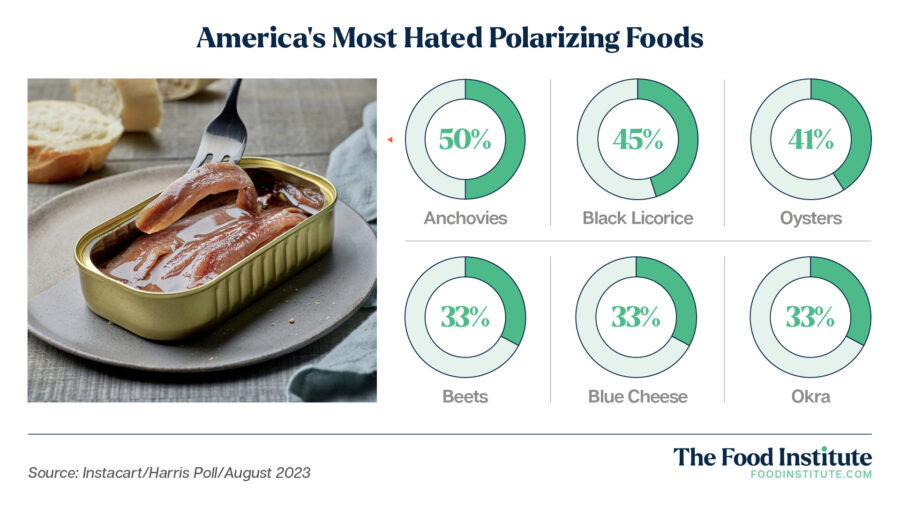Polarizing foods can generate criticism, curiosity, and engagement among consumers. But who are the leading offenders in this category, and can food industry operators leverage this love/hate relationship to drive engagement?
“By highlighting the unique and distinct flavors of polarizing foods, operators can attract adventurous eaters and enthusiasts who relish the unconventional,” said Jon Morgan, CEO of Venture Smarter, to The Food Institute. “[By] capitalizing on these foods’ exclusivity, operators can position them as signature items, fostering a sense of identity and belonging for customers who appreciate daring choices.”
Survey Says….
According to a new report using Harris Poll survey insights & Instacart purchase data, anchovies, black licorice, and oysters are the most divisive eats among U.S. consumers. The top qualifications for controversy include smell, strong flavor, texture, and visual appearance.
“The complex interplay of these unique flavors and textures is likely why [these foods are] at the top of the list,” said Instacart Trends Expert, Laurentia Romaniuk, in a blog post. “It’s also the reason we’re not seeing foods like white bread show up.”
Other noteworthy items in the top ten include capers, brussels sprouts, and cilantro.
Leveraging the Love/Hate
Despite all the contention, the survey also revealed that nearly 7 in 10 Americans have encountered a food that they initially disliked but eventually grew to enjoy. Furthermore, 37% said they are eager to try new foods that have a questionable reputation, signaling opportunities for engagement.
Due to the highly competitive nature of the food industry, finding innovative ways to drive sales is essential. As Morgan notes, implementing sales and marketing strategies around products that evoke strong reactions presents a range of opportunities, including differentiation.
“By emphasizing the distinctiveness of these foods and crafting narratives around their historical or cultural significance, operators can intrigue consumers and create memorable experiences,” said Morgan. “Additionally, interactive experiences, such as themed tasting events, can provide a platform for consumers to share their experiences and opinions, further enhancing engagement.”
However, operators must be prepared to handle diverse reactions and tailor their strategies accordingly. Managing consumer feedback is also essential—some patrons might be drawn to the challenge of eating outside their comfort zone while others may be put off, so authenticity and transparency are paramount.
“Overcoming aversions might involve creative menu combinations, where the polarizing ingredient is balanced with complementary flavors to make it more palatable for a broader audience,” Morgan concluded. “Balancing the novelty factor with broader culinary appeal can be complex but rewarding.”
The Food Institute Podcast
Everyone in the food industry wants to crack the code on Gen Z, but what are the reasons behind the generation’s food purchases? Alpha-Diver president Hunter Thurman joined The Food Institute Podcast to discuss some surprising findings from the Gen Z edition of the Snack 50 report and some of the psychological components that pushes Gen Z towards certain products and brands.





